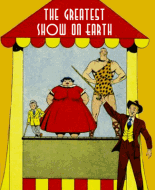Brenda Starr 1 (Dell)
Dell comics from this period are my favorite oddball brand. Since the 1930s, Dell had partnered with Western Printing & Lithographing to produce comics. Dell bankrolled and distributed, and Western provided the content. When Western decided to go it alone in the early 1960s, launching Gold Key, Dell was left up a creek. All the juicy media licenses that made Dell comics successful--the Disney titles, TV adaptations, movie tie-ins, etc.--were held by Western, not Dell. Dell had to scramble to find new material. They ended up with a continually-changing mix of original series and second-string media adaptations. A lot of unusual, off-the-wall, and downright weird comics resulted.
Brenda Starr seems to be one of the many titles Dell threw onto the wall to see if it'd stick. I guess it didn't, as there was only one issue. Like I said before the artwork looks like the strip I remember from my youth, which would have been right about the time this issue appeared. I agree with the GCD that it isn't by Messick or her staff. Some of the secondary characters remind me of Henry Scarpelli, who drew other TV adaptations at this time. However I'm no Scarpelli expert.
There are a lot of scenes of people standing around talking, so it's no surprise the artist resorted to the old talking-building shot more than once. Some of his choices make me wonder if he was making fun of the endless chatter. Especially our page 9, where instead of the speaking characters we get shots of a photographer walking down a hall and a couple sharing sodas in a distant restaurant.
What I noticed most about the story is the peculiar pacing. Many sequences are padded out, splitting dialogue over two panels when it could have--should have--been in one. The most obvious example is on the first page, panels 2 and 3. One panel for Twirl saying "Teaser?" and another for Teaser answering "Yes, Twirl?" Actually both panels are unnecessary. The women could have introduced themselves while discussing Brenda's flight on the next page. This happens repeatedly (see for example the scene with the bellhop on page 16), moderately important scenes given too much space.
Then, when something more important happens, it's cut to nothing! The worst example is on pages 19-21. Two and a half pages of chitchat end with Brenda and Jackpot in a taxi en route to the mysterious woman's final destination (page 21, panel 1) to snoop around. The next instant it's tomorrow and Brenda is in the paper's reference library looking for info about someone named Olga Volga. Apparently Brenda and Jackpot discovered where the mystery woman lived and somehow learned her name. That is an important scene, a scene we've spent three pages building up to, and it doesn't appear! One gets the impression the scriptwriter wasn't accustomed to writing comics. Too bad, because these early Dells had 32 beautifully-printed story pages, enough room for a more complex story than the average comic book.
Despite Hank's extensive exposition in the opening pages, the story probably would have made more sense to a reader of the newspaper strip than to someone new to the character. One last sour note. The crowd in the newsroom finally figure out the fake black orchid gives off a toxic gas. So what do they do? They toss it out the window into the street where it can gas a few passersby!
 Author
Topic: Reading Group #346 - Brenda Starr, Reporter - Female artist and iconic character (Read 445 times)
Author
Topic: Reading Group #346 - Brenda Starr, Reporter - Female artist and iconic character (Read 445 times)


